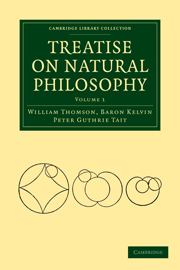Appendix B - Continuous Calculating Machines
Published online by Cambridge University Press: 07 September 2010
Summary
TIDE-PREDICTING MACHINE.
The object is to predict the tides for any port for which the tidal constituents have been found from the harmonic analysis from tide-gauge observations; not merely to predict the times and heights of high water, but the depths of water at any and every instant, showing them by a continuous curve, for a year, or for any number of years in advance.
This object requires the summation of the simple harmonic functions representing the several constituents* to be taken into account, which is performed by the machine in the following manner:—For each tidal constituent to be taken into account the machine has a shaft with an overhanging crank, which carries a pulley pivoted on a parallel axis adjustable to a greater or less distance from the shaft's axis, according to the greater or less range of the particular tidal constituent for the different ports for which the machine is to be used. The several shafts, with their axes all parallel, are geared together so that their periods are to a sufficient degree of approximation proportional to the periods of the tidal constituents. The crank on each shaft can be turned round on the shaft and clamped in any position : thus it is set to the proper position for the epoch of the particular tide which it is to produce. The axes of the several shafts are horizontal, and their vertical planes are at successive distances one from another, each equal to the diameter of one of the pulleys (the diameters of these being equal). The shafts are in two rows, an upper and a lower, and the grooves of the pulleys are all in one plane perpendicular to their axes.
Suppose, now, the axes of the pulleys to be set each at zero distance from the axis of its shaft, and let a fine wire or chain, with one end hanging down and carrying a weight, pass alternately over and under the pulleys in order, and vertically upwards or downwards (according as the number of pulleys, is even or odd) from the last pulley to a fixed point.
- Type
- Chapter
- Information
- Treatise on Natural Philosophy , pp. 479 - 508Publisher: Cambridge University PressPrint publication year: 2009First published in: 1883
- 1
- Cited by

